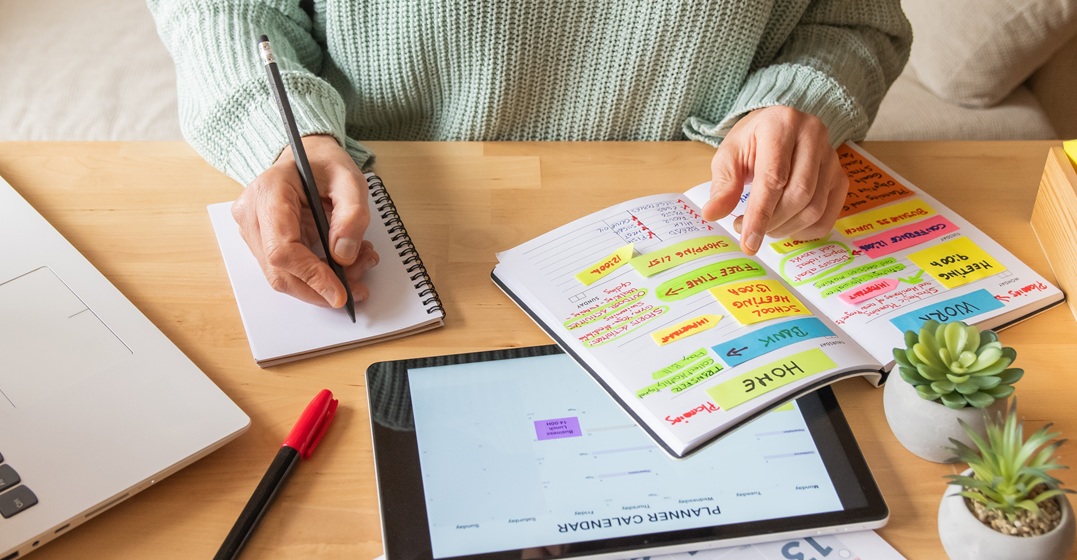A quick guide to Italian adjectives

Adjectives add depth, detail, and personality to speech and writing. In Italian, adjectives not only describe or modify nouns but play a crucial role in sentence structure, too.
In this article, we’ll cover the essential rules for using adjectives in Italian, including their agreement with nouns and position within a sentence. We’ll review irregular adjective forms, learn some of the most common adjectives in everyday speech, and share some tips on stylistic nuances.

Learn Italian with Lingoda
How it works

What are adjectives in Italian and how do they work?
Let’s start with the basics. What are adjectives, and what’s their role in an Italian sentence?
Definition and role of adjectives in Italian
Adjectives are words used to describe or modify nouns. They’re used to provide additional information about the quality or quantity of a noun. For example, in Italian we might say:
- Un gatto nero dorme. (A black cat is sleeping.)
Here, nero (black) is an adjective modifying the noun gatto (cat).
Italian vs. English adjectives: Key differences
In Italian, adjectives generally come after the noun they describe. In this way, Italian adjectives differ from English adjectives, which typically precede the noun.
As Italian is a Romance language, it should come as no surprise that gender plays a role in adjectival grammar. As a general rule, all adjectives in Italian must agree with the gender (masculine or feminine) and number (singular or plural) of the noun they modify.
Gender and number agreement for Italian adjectives
Gender agreement rules for Italian adjectives
Adjectives describing masculine nouns usually end in -o, whereas the -a ending is used for adjectives describing feminine nouns.
- un ragazzo alto (a tall boy)
- una ragazza alta (a tall girl)
But this isn’t always the case. Some adjectives use the ending -e when modifying both masculine and feminine nouns.
- un libro interessante (an interesting book)
- una storia interessante (an interesting story)
Plural forms of Italian adjectives
| Rule | Masculine, singular | Masculine, plural | Feminine, singular | Feminine, plural |
| -o changes to -i -a changes to -e | il ragazzo alto (the tall boy) | i ragazzi alti (the tall boys) | la ragazza alta (the tall girl) | le ragazze alte (the tall girls) |
| -e changes to -i, regardless of the gender | il libro interessante (the interesting book) | i libri interessanti (the interesting books) | la storia interessante (the interesting story) | le storie interessanti (the interesting stories) |
| -ista (both masc. and sing.) changes to -isti (masc.) and to -iste (fem.) | un uomo ottimista (an optimistic man) | uomini ottimisti (optimistic men) | una donna ottimista (an optimistic woman) | donne ottimiste (optimistic women) |
Irregular Italian adjectives
Italian has several irregular adjectives that don’t follow the standard rules. The most common are:
| Comparative | Superlative | |
| buono (good) | migliore (better) | ottimo (best) |
| cattivo (bad) | peggiore (worse) | pessimo (worst) |
| grande (big) | maggiore (bigger) | massimo (biggest) |
| piccolo (small) | minore (smaller) | minimo (smallest) |
Types of adjectives in Italian
Possessive adjectives
| Masculine singular | Feminine singular | |||
| my | il mio | il mio cane (my dog) | la mia | la mia casa (my house) |
| your | il tuo | il tuo cane | la tua | la tua casa |
| his/her | il suo | il suo cane | la sua | la sua casa |
| our | il nostro | il nostro cane | la nostra | la nostra casa |
| your (pl.) | il vostro | il vostro cane | la vostra | la vostra casa |
| their | il loro | il loro cane | la loro | la loro casa |
| Masculine plural | Feminine plural | |||
| my | i miei | i miei amici (my friends) | le mie | le mie sorelle (my sisters) |
| your | i tuoi | i tuoi amici | le tue | le tue sorelle |
| his/her | i suoi | i suoi amici | le sue | le sue sorelle |
| our | i nostri | i nostri amici | le nostre | le nostre sorelle |
| your (pl.) | i vostri | i vostri amici | le vostre | le vostre sorelle |
| their | i loro | i loro amici | le loro | le loro sorelle |
Note: Similarly to English, possessive adjectives in Italian can sometimes replace nouns to avoid redundancy. In these cases, the article precedes the adjective, agreeing with its gender and number. For example:
- Mio fratello suona la chitarra. Il suo suona la batteria. (My brother plays guitar. Hers plays the drums.)
In the above example, il (determinate article) + suo (possessive adjective) replaces suo fratello (her brother) in the second sentence. It’s apparent from the context that we are referring to “her brother.”

Learn Italian with Lingoda
How it works

Demonstrative adjectives
Demonstrative adjectives indicate the proximity of a noun relative to the speaker.
| Adjective variant | Masculine, singular | Masculine, plural | Feminine, singular | Feminine, plural |
| questo/a | questo libro (this book) | questi libri (these books) | questa penna (this pen) | queste penne (these pens) |
| quello + s + consonant, x, y, z, gn, ps, pn | quello students (that student) | quegli student (those students) | n/a | n/a |
| quel + consonant | quel libro (that book) | quei libri (those books) | n/a | n/a |
| quell’ + vowel | quell’ amico (that friend) | quegli amici (those friends) | quell’ amica (that friend) | quelle amiche (those friends) |
| quella + consonant | n/a | n/a | quella tavola (that table) | quelle tavole (those tables) |
Indefinite and quantitative adjectives
Indefinite and quantitative adjectives describe nouns in a nonspecific way. They
provide general information about quantity or type, without exact numbers or characteristics.
| Type | Meaning | Masculine, sing. | Masculine, plur. | Feminine, sing. | Feminine, plur |
| Indefinite | some, a few | qualche | qualche | ||
| alcuni | alcuni | ||||
| each, every | ogni | ogni | |||
| any, whichever | qualunque | qualunque | |||
| Quantitative | much, many | molto* | molti* | molta* | molte* |
| tanto* | tanti* | tanta* | tante* | ||
| few, little | poco | pochi | poca | poche | |
| too much/many | troppo | troppi | troppa | troppe | |
| all, every | tutto | tutti | tutta | tutte |
* Molto and tanto are generally interchangeable, but:
- When they precede nouns, they must agree in number and gender
- Before adjectives and adverbs, molto is preferred. So you would say molto veloce (very fast) instead of tanto veloce.
- Before meglio (better), peggio (worse), più (more), meno (less), prima (before) and dopo (after), molto is preferred.
- You can’t use them together!
Descriptive adjectives
Descriptive adjectives provide specific details about a noun's qualities or characteristics, such as its color, size, shape or personality.
- La casa grande è vicino al lago. (The big house is near the lake.)
- Il gatto nero dorme sul divano. (The black cat is sleeping on the couch.)
- Abbiamo trovato un fiore bellissimo. (We found a beautiful flower.)
Placement of adjectives in Italian sentences
Descriptive adjectives typically come after the noun, and they describe qualities like color, shape or mood:
- Un libro interessante → an interesting book
- Una macchina veloce → a fast car
Quantifiers and possessives, however, usually come before the noun:
- La mia casa → my house
- Troppo zucchero (fa male) → too much sugar (is bad for you)
Some adjectives can also subtly change the meaning or emphasis, depending on their position:
- Un grande uomo → a great man (in terms of character)
- Un uomo grande → a big man (in terms of size)
Lists of essential Italian adjectives by category
The following lists of adjectives aren’t exhaustive, but they’ll give you a solid base to start building your vocabulary.
Adjectives for physical descriptions
| tall | alto/a | al-toh | Lei è alta. (She is tall.) |
| short | basso/a | bah-soh | Mia sorella è bassa. (My sister is short.) |
| thin | magro/a | mah-groh | Lui è sempre stato magro. (He has always been thin.) |
| fat | grasso/a | grah-soh | Il gatto è un po' grasso. (The cat is a bit fat.) |
| beautiful | bello/a | beh-loh | Roma è bellissima. (Rome is beautiful.) |
| ugly | brutto/a | broo-toh | Oggi è una giornata brutta. (Today is an ugly day.) |
| young | giovane | jioh-vah-neh | Mio cugino è giovane. (My cousin is young.) |
| old | vecchio/a | ve-kioh | Lui ha un cane vecchio. (He has an old dog.) |
Adjectives for common situations
| important | importante | eem-por-tan-teh | Questa riunione è importante. (This meeting is important) |
| easy | facile | fah-chee-leh | Il compito è facile. (The homework is easy.) |
| difficult | difficile | dee-fee-chee-leh | Questo esame è difficile. (This exam is difficult.) |
| fun | divertente | dee-ver-ten-teh | La festa è stata divertente. (The party was fun.) |
| boring | noioso/a | noh-ee-oh-soh | Il film era noioso. (The movie was boring.) |
| simple | semplice | sem-plee-cheh | La ricetta è semplice. (The recipe is simple.) |
| complicated | complicato/a | com-plee-kah-toh | Il progetto è complicato. (The project is complicated.) |
| convenient | conveniente | con-veh-nee-en-teh | Questi prezzi sono convenient. (These prices are convenient.) |

Learn Italian with Lingoda
How it works

Adjectives for personality and mood
| happy | felice | feh-lee-cheh | Oggi sono felice! (Today I am happy!) |
| sad | triste | tris-teh | Lui è triste. (He is sad.) |
| kind | gentile | jen-tee-leh | La mia collega è gentile. (My colleague is kind.) |
| patient | paziente | pah-tsee-en-teh | Il professore è molto paziente. (The teacher is very patient.) |
| energetic | energico/a | eh-ner-jee-coh | Mia madre è energica. (My mother is energetic.) |
| calm | calmo/a | kal-moh | Lui è sempre calmo. (He is always calm.) |
| optimistic | ottimista | oh-tee-mees-tah | Loro sono ottimisti. (They are optimistic.) |
| pessimistic | pessimista | peh-see-mees-tah | Non essere pessimista. (Don’t be pessimistic.) |
Adjectives for food and flavor
| delicious | delizioso/a | deh-lee-tseeoh-soh | Questo dessert è delizioso! (This dessert is delicious!) |
| flavorful | saporito/a | sah-poh-ree-toh | Il sugo è molto saporito. (The sauce is very flavorful.) |
| spicy | piccante | peek-kan-teh | Questa salsa è piccante. (This sauce is spicy.) |
| sweet | dolce | dohl-cheh | La torta è dolce. (The cake is sweet.) |
| bitter | amaro/a | ah-mah-roh | Il caffè è amaro. (The coffee is bitter.) |
| salty | salato/a | sah-lah-toh | Il formaggio è salato. (The cheese is salty.) |
| sour | acido/a | ah-chee-doh | Il limone è acido. (The lemon is sour.) |
| fresh | fresco/a | fres-coh | Questo pesce è fresco. (This fish is fresh.) |
| juicy | succoso/a | soo-coh-soh | Questo pomodoro è succoso. (This tomato is juicy.) |
| tasty | gustoso/a | goos-toh-soh | Il risotto è gustoso. (The risotto is tasty.) |
FAQs
Do adjectives have gender in Italian?
Yes, they change to match the gender and the number of the noun they describe.
What are the four possible endings for adjectives in Italian?
While there are several possible endings in Italian (-ista, -ante), the ending vowel usually gives you an idea of what gender they match with: -o (masculine singular), -a (feminine singular), -i (masculine plural), and -e (feminine plural).
What are the most frequently used adjectives in Italian?
Among the most frequently used adjectives in Italian, you find: bello (beautiful), buono (good), grande (big, great), piccolo (small), nuovo (new), vecchio (old), giovane (young), alto (tall, high), basso (short, low), bravo (talented, good)
Ultima nota (one last note, before you go)
Learning Italian adjectives is an essential step on your path to fluency. They take many shapes and forms, but these words will enrich your conversations and descriptions. With practice, you’ll not only expand on the pool of adjectives you have available, but you’ll feel more confident when using them. If you choose to learn Italian with Lingoda, rest assured that you’ll be propelled toward that confidence in an interactive and immersive setting.

Learn Italian with Lingoda
How it works














